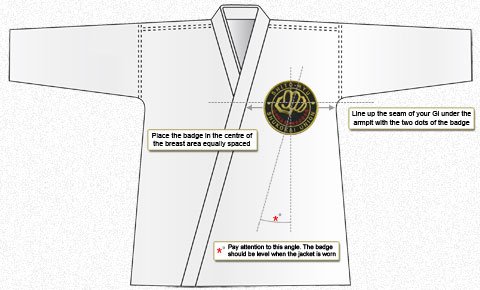Child Protection or further information:
The YSSKWU UK is a world recognised association and has developed a Child Protection Policy for implementation by its member clubs throughout the United Kingdom.
The official SSU Gi badge should be purchased only from either the Chief Instructor (Denis Casey) or an association instructor of representative. The badge is 4.5" (11.5cm) in diameter and should be placed on the left breast pocket area of the jacket as shown in the diagram. It should be firmly attached by sewing in place as iron-on backings are not secure enough whilst training.
Place the badge horizontally in the centre of the breast area making sure that it is level when you will wear it as the overlap of the jacket isn't vertical.
Try to align the two dots on the badge with the seam under the armpit when the sleeve is raised.
Please note:
NO OTHER BADGES, LOGOS OR INSIGNIA SHOULD BE ADDED TO YOUR GI UNLESS AGREED BY THE CHIEF INSTRUCTOR OF THE ASSOCIATION
- - Gi Badge Placement Guidelines - -
10 RULES FOR A HEALTHY DOJO
1. If you’re feeling sick please stay at home.
Don’t infect your classmates. Rest, recuperate and come back stronger!
2. Personal hygiene is important.
Everyone appreciates a clean, fresh training partner.
3. Keep your fingernails and toenails short and groomed.
Avoid scratching your partners - It’s annoying, painful and takes time to heal.
4. Tape up any cuts, cover any grazes.
Protect yourself from infection and prevent cuts from opening up.
5. Wash your hands before and after every dojo session.
Soap and hot water is best. However, hand sanitizer is the next best thing.
6. Always use footwear when visiting the toilet.
Socks don’t count. Please remove belt/gi jacket and wear footwear when visiting the toilet.
7. No shoes on the mats. No bare feet off the mats.
Mats are expensive - let’s not scuff or tear them. Shoes carry a multitude of germs on to the mat.
8. If you sweat a lot bring a towel.
A simple courtesy to all your training partners!
9. Remove or cover piercings or jewellery.
Avoid catching and injuring yourself or your partner. Also, avoid damaging your valuables.
10. Wash your Gi and any other training wear regularly.
Wipe down your mits/gloves, wash your gum shield!
Grading Advice (8th Kyu - 1st Kyu):
- Ensure that you have trained regularly and thoroughly in the techniques and Kata for the grade you hope to achieve.
- Make sure you have a current licence, you cannot be graded if you are not licenced.
- You must try your best throughout the grading. A grade is awarded on the quality of your performance i.e. good strong stances, snappy techniques, good hip movements, posture and concentration.
- Your Kata should be a combination of technical skill, power and concentration and should not be rushed. Do not become distracted and concentrate on the job in hand.
- If you do not understand the examiner’s request, ask for it to be repeated. Failure to understand the Japanese terminology will not necessarily go against you, however, you should know the names of the basic techniques.
- When called before the examiner quickly move into position and do not forget to bow correctly (a nod of the head is not sufficient), a long deep bow is required.
- When waiting your turn to be called, do not lean against the walls and please keep silent when others are grading.
- To avoid disruption of the grading please visit the bathroom before entering the dojo.
- Remember the examiner is not there to fail you, he wants you to pass but you have to do the right thing during the grading.
- All students should wear a clean white Gi with the correct association badge on the left breast of the jacket. Finger/toe nails need to be kept short and no jewellery is to be worn on the grading.
Relevant Katas:
- Shio-Tsuki (X Kata)
- Ju Ni No Kata (H Kata)
- Pinan Nidan
- Pinan Shodan
- Pinan Sandan
- Pinan Yondan
- Pinan Godan
- Sanchin
- Juroku
- Tensho
- Naifanchi Shodan
- Matsukaze
- Bassai-dai
- Kosokun-dai
Grading Notes:
- Combinations should be practised in both Kihon and Kumite forms, and on both the left and right hand sides.
- A minimum of three months between each grading is needed. Based on training twice a week (6 months for Brown belt).
- All Katas relevant to your grading need to be practised continually and perfected and performed at the correct pace.
- Shio-tsuki kata is for 11yrs and under. Ju-ni-no kata is for 12yrs and older.
- 1 Black stripe is to be affixed to the Brown belt for 3rd Kyu, 2 for 2nd Kyu and 3 Black stripes for 1st Kyu.
- Above is an extract from the Members Handbook/Grading Syllabus. Please refer to this for full details. For the Dan grading policy speak to your instructor or the association Chief Instructor (Denis Casey Sensei - 8th Dan).












